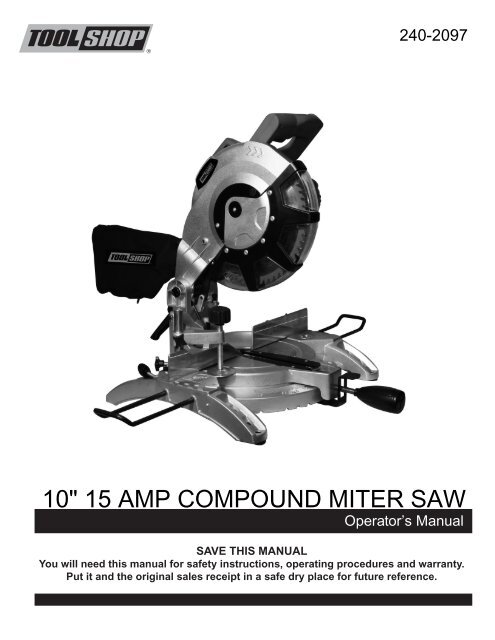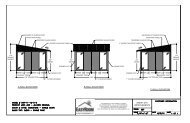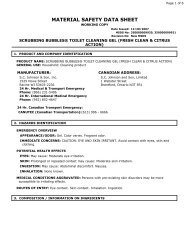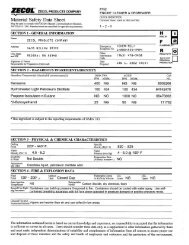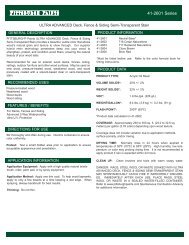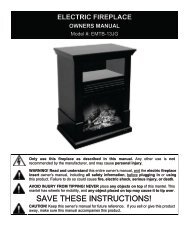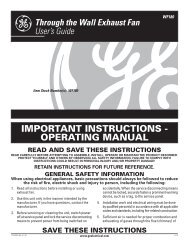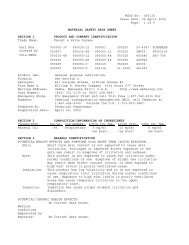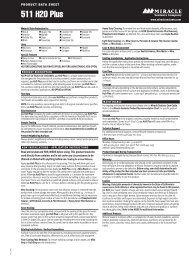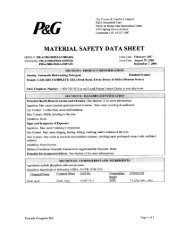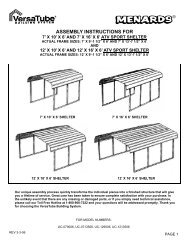10" 15 AMP COMPOUND MITER SAW - Menards
10" 15 AMP COMPOUND MITER SAW - Menards
10" 15 AMP COMPOUND MITER SAW - Menards
Create successful ePaper yourself
Turn your PDF publications into a flip-book with our unique Google optimized e-Paper software.
240-2097<br />
10" <strong>15</strong> <strong>AMP</strong> <strong>COMPOUND</strong> <strong>MITER</strong> <strong>SAW</strong><br />
Operator’s Manual<br />
SAVE THIS MANUAL<br />
You will need this manual for safety instructions, operating procedures and warranty.<br />
Put it and the original sales receipt in a safe dry place for future reference.
2<br />
IMPORTANT SAFETY INSTRUCTIONS<br />
WARNING: When using electric tools, machines or equipment, basic safety<br />
precautions should always be followed to reduce the risk of fire, electric<br />
shock, and personal injury.<br />
READ ALL INSTRUCTIONS BEFORE USING THIS TOOL<br />
1. KEEP WORK AREA CLEAN. Cluttered areas can cause injuries.<br />
2. CONSIDER WORK AREA ENVIRONMENT. Don’t use power tools in damp,<br />
wet, or poorly lit locations. Don’t expose tools to the rain. Keep the work area<br />
well lit. Don’t use tools in the presence of flammable gases or liquids.<br />
3. KEEP CHILDREN AND BYSTANDERS AWAY. All children should be kept<br />
away from the work area. Don’t let them handle machines, tools or extension<br />
cords. Bystanders can be a distraction and can be injured.<br />
4. GROUNDED TOOLS must be plugged into an outlet that is properly<br />
installed and grounded. Grounding provides a low-resistance path to carry<br />
electricity to the ground away from the operator, should the tool malfunction elec- -<br />
trically. Do not remove the grounding prong from the plug or alter the plug in<br />
any way. If in doubt as to whether the outlet is properly grounded according<br />
to code, check with a qualified electrician.<br />
5. OBSERVE PROPER PRECAUTIONS REGARDING DOUBLE INSULA-<br />
TION. This tool is double insulated. It is equipped with a polarized plug.<br />
One blade is wider than the other, so it will fit into a polarized outlet only one<br />
way. If you have difficulty inserting the plug, try reversing it. If it still doesn’t<br />
fit , do not alter the plug; have a qualified electrician install a polarized outlet.<br />
6. GUARD AGAINST ELECTRIC SHOCK. Prevent body contact with grounded<br />
surfaces: pipes, radiators, ranges, and refrigerator enclosures. When your<br />
body is grounded the risk of electric shock increases. When working wherever<br />
“live” electrical wires may be encountered, try to ascertain whether<br />
there is a danger of shock. DO NOT TOUCH ANY METAL PARTS<br />
OF THE TOOL while using it. Hold the tool only by the plastic grip to prevent<br />
electric shock if you contact a live wire.<br />
7. DO NOT MISUSE THE CORD. Never carry your tools by the cord or pull on<br />
the cord to unplug it. Protect the cord from potential sources of damage:<br />
heat, oil & solvents, sharp edges, or moving parts. Replace damaged cords<br />
immediately.<br />
8. WHEN WORKING OUTDOORS, USE AN OUTDOOR-RATED EXTENSION<br />
CORD. An extension cord rated for outdoor use must be marked “W-A” or<br />
“W”.<br />
9. DO NOT EXPOSE ELECTRICAL POWER TOOLS TO MOISTURE. Rain or<br />
wet conditions can cause water to enter the tool and lead to electric shock.<br />
10. ENSURE THE EXTENSION CORD YOU USE IS OF SUFFICIENT GAUGE<br />
FOR ITS LENGTH.<br />
Recommended Minimum Wire Gauge for Extension Cords<br />
Amps from Tool Nameplate 25’ length 50’ length 75’ length 100’ length <strong>15</strong>0’ length 200’ length<br />
0-5 amps 16 ga. 16 ga. 16 ga. 14 ga. 12 ga. 12 ga.<br />
5.1-8 amps 16 ga. 16 ga. 14 ga. 12 ga. 10 ga. Do Not Use<br />
8.1-12 amps 14 ga. 14 ga. 12 ga. 10 ga. Do Not Use Do Not Use<br />
12.1-<strong>15</strong> amps 12 ga. 12 ga. 10 ga. 10 ga. Do Not Use Do Not Use<br />
<strong>15</strong>.1-20 amps 10 ga. 10 ga. 10 ga. Do Not Use Do Not Use Do Not Use<br />
11. STORE IDLE EQUIPMENT. Store equipment in a dry area to inhibit rust.<br />
Equipment also should be in a high location or locked up to keep out of<br />
reach of children.<br />
12. DON’T FORCE THE TOOL. It will do the job better and more safely at the<br />
rate for which it was intended.<br />
13. USE THE RIGHT TOOL. Don’t force a small tool or attachment to do the<br />
work of a larger industrial tool. Don’t use a tool for a purpose for which it was<br />
not intended.<br />
14. DRESS PROPERLY. Don’t wear loose clothing or jewelry; they can be<br />
caught in moving parts. Protective, non-electrically conductive gloves, protective<br />
eyewear and non-skid footwear are recommended. Wear protective hair<br />
covering to contain long hair and keep yourself from harm.<br />
!
IMPORTANT SAFETY INSTRUCTIONS<br />
<strong>15</strong>. USE EYE PROTECTION. Use a full-face mask if the work you’re doing<br />
produces metal filings, dust or wood chips. Goggles are acceptable in other<br />
situations. Wear a clean dust mask if the work involves creating a lot of fine<br />
or coarse dust.<br />
16. SECURE WORK. Use clamps or a vise to hold the work, this frees both<br />
hands to operate the tool.<br />
17. DON’T OVERREACH. Keep proper footing and balance at all times. Do not<br />
reach over or across machines that are running.<br />
18. MAINTAIN TOOLS. Keep tools sharp and clean for better and safer<br />
performance. Follow instructions for lubricating and changing accessories.<br />
For safe performance. Keep handles dry, clean and free from oil and grease.<br />
19. AVOID UNINTENTIONAL STARTING. Be sure the switch is in the OFF position<br />
before plugging in.<br />
20. ALWAYS CHECK AND MAKE SURE TO REMOVE ANY ADJUSTING KEYS<br />
OR WRENCHES before turning the tool on. Left attached, these parts can fly<br />
off a moving part and result in injury.<br />
21. DO NOT USE THE TOOL IF IT CANNOT BE SWITCHED ON OR OFF.<br />
Have your tool repaired before using it.<br />
22. DISCONNECT THE PLUG FROM THE POWER SOURCE BEFORE MAKING<br />
ANY ADJUSTMENTS. Changing attachments or accessories can be dangerous<br />
if the tool could accidentally start.<br />
23. STAY ALERT. Watch what you are doing & use common sense. Don’t operate<br />
any tool when you are tired.<br />
24. CHECK FOR DAMAGED PARTS. Before using this tool, any part that is<br />
damaged should be carefully checked to determine that it will operate properly<br />
and perform its intended function. Check for alignment of moving parts,<br />
binding of moving parts, breakage of parts, mountings, and other conditions<br />
that may affect its operation. Inspect screws and tighten any ones that are<br />
loose. Any part that is damaged should be properly repaired or replaced by<br />
an authorized service center unless otherwise indicated elsewhere in the instruction<br />
manual. Have defective switches replaced by an authorized service<br />
center. Don’t use the tool if switch does not turn it on and off properly.<br />
25. REPLACEMENT PARTS. When servicing, use only identical replacement<br />
parts.<br />
26. SERVICE AND REPAIRS should be made by qualified repair technicians at<br />
an authorized repair center. Improperly repaired tools could cause serious<br />
shock or injury.<br />
SAFETY PRECAUTIONS FOR <strong>COMPOUND</strong> <strong>MITER</strong> <strong>SAW</strong><br />
1.<br />
2.<br />
3.<br />
4.<br />
5.<br />
6.<br />
7.<br />
WOOD ONLY. The saw is designed for woodcutting only.<br />
DAMAGED OR WARPED <strong>SAW</strong> BLADES should not be used. They are out<br />
of balance and could cause further damage to the saw and possible personal<br />
injury.<br />
USE ONLY WITH GUARD IN PLACE. The guard protects the operator<br />
from cutting debris as well as from broken pieces of the blade, should it break<br />
in use.<br />
REPLACE THE TABLE INSERT WHEN WORN. Excessive tear-out increases<br />
the likelihood of injury from flying debris. When setting the saw at a new angle,<br />
check that the blade does not cut into the table insert, rear fence, or another<br />
part of your saw.<br />
ALWAYS USE THE BLADE WRENCH to tighten the saw blade onto the arbor.<br />
CONNECT YOUR <strong>MITER</strong> <strong>SAW</strong> TO A DUST COLLECTING DEVICE if possible.<br />
If not, use the dust bag that comes with the tool and empty it regularly.<br />
USE A <strong>SAW</strong>BLADE SUITED TO THE CUTTING JOB AND MATERIAL TO BE<br />
CUT.
4<br />
SAFETY PRECAUTIONS FOR <strong>COMPOUND</strong> <strong>MITER</strong> <strong>SAW</strong><br />
8. ALWAYS USE TABLE EXTENSIONS AND CL<strong>AMP</strong>S to support the material<br />
when sawing long work pieces.<br />
9. THE MATERIAL SHOULD BE PLACED FIRMLY AGAINST THE FENCE AND<br />
TABLE. The turning of the saw blade should force it down against the table<br />
and rearward against the fence during the cut. Movement of the workpiece<br />
during the cut may cause the blade to jam and create a kickback. When this<br />
happens, the cutting head may jump out of your hand or the workpiece may<br />
fly loose and cause serious injury.<br />
10. DO NOT START THE <strong>SAW</strong> WITH THE BLADE IN CONTACT WITH ANY<br />
SURFACE. This may cause the saw to bounce or kick back violently and could<br />
cause injury.<br />
11. IF MAKING A CUT USING ONE HAND TO HOLD THE <strong>SAW</strong>, ensure the free<br />
hand is clear of the cutting area.<br />
SPECIFICATIONS<br />
= Voltage: 120 volts AC, 60Hz.<br />
= Current rating: <strong>15</strong> Amps<br />
= No load speed: 4,500 RPM<br />
= 10” 60 tooth carbide tipped saw blade<br />
= 5/8” arbor size<br />
= Bevel cuts up to 45° left<br />
= Miter cuts up to 45° left & 45° right<br />
with detents at 0°, <strong>15</strong>°, 22.5°, 30°, & 45° left and right<br />
= Cutting Capacity 90°Cross Cut 2-7/8"x5-1/4"<br />
45°Miter Cut 2-7/8"x3-3/4"<br />
45°Bevel Cut 1-3/4"x5-1/4"<br />
45°Miter/Bevel Cut 1-3/4"x3-3/4"<br />
Contents:Miten Saw,(1)10"x60 Tooth Carbide Biade,Blade Wrench,(1)Hold-Down Ciamp,<br />
Wrench,(1)Hold-Down Ciamp,(2)Table Extensions,Dust Collection Bag & Product Manual<br />
FUNCTIONAL DESCRIPTION<br />
1. Trigger<br />
2. Brush cover<br />
3. Movable guard<br />
4. Saw blade<br />
5. Dust bag<br />
6. Bevel lock lever<br />
7. Hold-down clamp assembly<br />
8. Table extension<br />
9. Table extension lock<br />
10. Miter detent spring lever<br />
11. Locking handle<br />
12. Miter scale<br />
5<br />
8<br />
6<br />
7<br />
9<br />
12<br />
1<br />
3<br />
2<br />
4<br />
10<br />
11
OPERATING PROCEDURES<br />
CAUTION! Be sure the saw is disconnected from its power source before making<br />
any repaires or performing maintenance!<br />
MOUNTING AND REMOVING THE BLADE<br />
1. Unscrew the movable guard release screw and rotate the guard<br />
center plate around the movable guard pivot screw with the guard<br />
until it exposes the saw blade arbor screw.<br />
2. Engage the spindle lock by pressing the pin located between the<br />
handle and the fixed guard.<br />
CAUTION: Never press the spindle lock pin while the saw is running!<br />
3. Using protective gloves, rotate the blade by hand while pressing the pin until it<br />
engages a slot in the arbor.<br />
4. While holding the spindle lock pin in, and using the supplied wrench, unscrew<br />
the arbor screw, remove the outside saw blade flange, and the saw blade.<br />
5. When replacing the blade, apply the above procedure in reverse.<br />
6. Be sure that when mounting the new saw blade, the direction arrows on the<br />
blade correspond with the arrow on the guard.<br />
CL<strong>AMP</strong>ING WORKPIECE:<br />
WARNING: For safe and accurate cuts, fix workpiece firmly into cutting position<br />
with hold- down clamp, otherwise the tool and workpiece may be damaged.<br />
1. Mount the hold-down clamp on one side of fence. Insert shaft of the hold-down<br />
clamp into the mounting hole and tighten the hold-down clamp retainer screw<br />
to affix the shaft of the hold-down clamp.<br />
2. Adjust position of the hold-down clamp bracket according to the workpiece thickness<br />
and shape. Tighten the screw to fix the bracket in place.<br />
3. Make sure that when the handle is lowered, bevelled or angled in any position,<br />
no part of the tool contacts the hold-down clamp.<br />
START UP<br />
USING YOUR <strong>SAW</strong><br />
After unpacking, reading the instructions, attaching the machine to the workbench,<br />
and checking that all attachments are correctly installed, you can use your saw. Be<br />
sure to wear the appropriate protective equipment.<br />
1. Check to ensure everything is correctly attached, screws are fastened, and all<br />
adjusting keys and wrenches are removed.<br />
2. Connect the saw to power.<br />
3. Unlock the saw from its various storage and shipping positions.<br />
4. Pressing the trigger lock button, then squeezing the trigger switch in the<br />
handle, while holding the trigger lock button down, will start the saw<br />
The cutting head should be in the raised position and the blade fully enclosed<br />
in the guard before starting the miter saw.<br />
WARNING: Before plugging in, confirm that the trigger is normal. If the locking<br />
button is not depressed, do not pull the trigger with force as this may cause severe<br />
damage to the switch.<br />
REMEMBER:<br />
Before use, release the head lock button and raise the handle.<br />
Before turning on, confirm that the saw blade does not touch the work piece or<br />
the vise at any position.<br />
When cutting, press the handle down slowly. DO NOT force the handle,<br />
as this may cause damage to your saw.<br />
Before starting to cut, confirm that the saw blade has attained full speed. After<br />
cutting is complete wait until the rotation of the blade STOPS completely before<br />
lifting the handle to its top position.<br />
For your safety, remove chips, small pieces, etc. from the table top before<br />
operation.<br />
For best performance, ALWAYS keep saw blade clean and sharp.<br />
5
6<br />
OPERATING PROCEDURES<br />
5. To begin cutting, lower the cutting head. The movable guard opens automatically.<br />
6. After cutting, allow the head to come back up. The guard will close automatically.<br />
7. The saw will stop when you release the trigger switch in the handle.<br />
MODES OF USE<br />
Chop cut:<br />
The head is locked in the upright position. The table rotation is locked at 0°.<br />
This is a good setting for simple 90° crosscuts.<br />
Miter cut:<br />
The head is locked in the upright position. To unlock the table rotation, unscrew the<br />
locking handle and press on the miter detent spring lever<br />
with your thumb. Move the table rotation to the left or right up to 45° left & 45° right.<br />
The miter detent spring lever , if released, will stop the table at detents<br />
at 0°, <strong>15</strong>°, 22.5°, 30°, & 45° left and right. Use the locking handle to<br />
lock the table at the desired angle, especially those between the detents.<br />
Bevel cut:<br />
To unlock the head angle (bevel) adjustment, loosen the bevel lock handle<br />
at rear of the saw. Lock it when the blade is tilted at the desired angle.<br />
The table rotation is locked at 0°.<br />
Compound cut:<br />
Unlock and move the table rotation to the left or right as in miter cuts above. Using<br />
the lever at the back of the saw, unlock the head and bevel it to any position from<br />
0° – 45° left, then lock it in place.<br />
NOTE: At extreme positions, the hold-down clamp should be moved to the right<br />
side of the table to prevent interfering with the movement of the cutting head.<br />
Always check before making the cut if there is any potential interference from the<br />
clamp or any other part of the machine.<br />
MAINTENANCE<br />
NOTE: Even<br />
though the angles are marked on the machine, it is always a good<br />
idea to check them by making a trial cut. See Aligning Miter and Bevel, below.<br />
Inspect the cord regularly and have it replaced by an authorized repair facility if<br />
it is damaged.<br />
Check the brushes occasionally (after about 50 hours of use) and replace if<br />
worn. The brushes can be replaced by removing the motor back cap.<br />
The brushes and their springs could jump out of the holders- be careful<br />
not to lose them. Inspect the brushes. If the contact surface is not<br />
smooth, or it is worn or heavily used, replace both brushes. Insert the new<br />
brushes and springs in their holders and re-fasten the cap.<br />
The plastic kerf plate table insert should be replaced if damaged to reduce the<br />
risk of chips lodging in the slot and catching in the blade.<br />
Keep the vents clear of dust and debris. This will help prevent possible electrical<br />
shorts and ensure proper cooling.<br />
Keep the tool housing and handle clean and free of oil and grease by using mild<br />
soap and a damp (not wet) cloth.
MAINTENANCE<br />
ALIGNING <strong>MITER</strong> AND BEVEL<br />
Miters and bevels have been set at the factory. However, use may effect settings.<br />
Please use the following procedures when your tool needs adjustments.<br />
Miter Angle<br />
1. Set the bevel angle at 0 degree.<br />
2. Loosen the locking handle.<br />
3. Depress the miter detent spring lever.<br />
4. Turn the saw table so that the arrow in the kerf plate points to 0 degree, then<br />
move the table slightly clockwise and counter-clockwise and let the miter detent<br />
spring lever fit into the groove (it doesn’t matter if needle doesn’t indicate 0<br />
degree ).<br />
5. Loosen the four hex bolts behind the fence with the blade socket wrench.<br />
6. Lower the saw head and lock it in place with the head lock button.<br />
7. Use the clear plastic setup triangle to check that the saw blade and the fence<br />
are square. Move the fence a few millimeters to achieve this if<br />
necessary.<br />
8. Tighten the hex bolts in the fence firmly.<br />
9. Confirm that the arrow in the kerf plate points to 0 degree. If not, loosen the<br />
two screws in the bottom of the miter detent spring lever and adjust accordingly.<br />
Bevel Angle<br />
A. Vertical stop: 0 degree adjustment<br />
1. Lower the saw head to it’s lowest position and lock it with the head lock button.<br />
2. Loosen the bevel lock handle on the back of the saw.<br />
3. Check that the blade is perpendicular to the table as measured by the clear<br />
plastic setup triangle. If not :<br />
a. Use an open-end wrench to loosen the hex lock nut and then turn the hex<br />
stop bolt at the back right side of the table.<br />
b. Turn the bolt counter-clockwise and the 0 point moves left, closing the angle.<br />
Turning it clockwise moves the 0 point to the right, opening the angle.<br />
c. When you have established the vertical stop correctly, tighten the lock nut<br />
down to hold the setting.<br />
d. Make sure that the needle points to 0 degree on the scale. If not, loosen<br />
the screws and adjust the needle.<br />
B. Bevel stop: 45 degrees adjustment<br />
1. Lower the saw head to it’s lowest position and lock it with the head lock button.<br />
2. Loosen the bevel lock handle on the back of the saw.<br />
3. Check that the blade is at 45 degrees to the table as measured by the clear<br />
plastic setup triangle. If not :<br />
a. Use an open-end wrench to loosen the hex lock nut and then turn the hex<br />
stop bolt at the back left side of the table.<br />
b. Turn the bolt clockwise and the 45 degrees point moves left, opening the angle.<br />
Turning it counter-clockwise moves the 45 degrees stop to the right, closing<br />
the angle.<br />
c. When you have established the 45 degrees stop correctly, tighten the lock nut<br />
down to hold the setting.<br />
d. Make sure that the needle points to 45 degrees on the scale. If not, loosen the<br />
screws and adjust the needle.
!<br />
SCHEMATIC DRAWING<br />
WARNING Repairs should be made by an authorized repair center. Do not<br />
open or disassemble<br />
this power tool. Contact at 1-866-9<strong>15</strong>-8626<br />
for questions regarding this power tool.<br />
9999<br />
9


